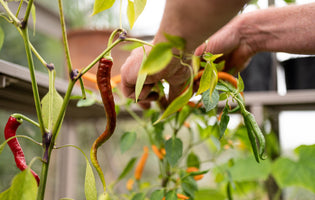I always thought blackberries were an autumn fruit, but actually, the first inky berries can be found speckling the briar as early as July, when the sun is still warm and everything around us is bright and colorful. By the time the leaves start to fall from the trees, most of the blackberries are gone. Of course, the birds make light work of them, but they provide sustenance for all sorts of wildlife. Butterflies and moths love the dark sugary juices; squirrels will take advantage, before moving on to the richer nuts and seeds of October. There might even be a little family of Dormice quietly scaling the tangle of thicket looking for fruits to eat. Then, every year, in early September I hear the smash and clatter of tines and chains as the farmers' tractor rumbles down the track with its hedge cutter whirring away. That marks the end of the blackberry season around here, then I know it’s really autumn.
The vegetable garden is surrounded by bramble, which I rather like. Its thorny twists weave their way over the fence; they creep around the compost bins and breach the various patches, but as long as I keep them in check, I see them as friends, over foes. Looming out of the blackberry bushes there’s a big ash tree. It sits to the northeast of the garden, so doesn’t shade the plants in any way, but sometimes I look up at its overhanging limbs and wonder how long it’ll stand up to the ash dieback that’s sweeping through the woodland down here on the southwest coastline. However, I’m relieved to say, that right now, it’s only the ash leaves that are drifting lazily down to earth, and nothing heavier. But it’s not only ash leaves that are piling up in corners and filling the greenhouse gutters, oak, maple, chestnut and beech leaves all end up carpeting the beds in autumn’s finest hues. A lot of these leaves become mulch of their own accord. I can’t see the point in raking them off the beds, before long their frail frames become part of the soil anyway. A least half a dozen barrows of soggy leaves end up in the compost, which is great. They help to balance out the nitrogen-rich grass cuttings that make up spring and summer compost contributions.
We’ve had a fantastic haul of tomatoes from the greenhouse this year, which we’ve been enjoying very much. Happily, I avoided the blight too, so we’ve been bringing in basket after basket of plump, ripe, red tomatoes which end up being eaten in all sorts of delicious ways. They’ve been such a treat and continue to be, in the form of chutneys and roast tomato sauce, which I’ve popped in tubs in the freezer. Around the tomatoes I’ve grown cucumbers again (It’s hard not to) and they’ve been fabulous (again) Loads of pickling and salads and raita, and I’ve been making the occasional sorbet too, with mint and a spritz of lemon – it’s a cool and refreshing way to eat them.
Last week I spent the day clearing out the greenhouse in preparation for the winter ahead. It had become pretty wild in there. Pulling out the tomato and cucumber plants, sweeping up and generally packing things away is a very cathartic exercise, but also an important one. Now I’m waiting for my friend, who has a farm, to deliver a big trailer of manure for the beds. So I can enrich the soil and plant some winter salads and herbs.
Frustratingly, some of my vegetables in the raised beds haven’t done very well this year. I don’t think I took into account the importance of crop rotation in the way I should have. I was diligent about feeding the soil with homemade compost and horse manure once I’d harvested things, but that didn’t seem to help, if I grew the same crops in the same spots again, they’d be sluggish, slow to grow and small. My celeriac has also caused me a bit of a headache. It’s a vegetable I love, but it’s the first time I’ve tried to grow it myself. The seeds germinated as they should, and the seedlings appeared healthy when I put them in the ground, but they just never grew. I know they’re notoriously tricky, but I definitely need some advice on these troublesome roots.
Gladly lots of my veg has done well. Courgettes, beans, beetroot, kale, carrots, onions and garlic have all fruited in abundance and have carried on producing right up until now. One of my Favorite ways to use this plethora of seasonal veg is in a delicious garden soup, for which I have a recipe here.
Autumn vegetable soup

You can make this soup, or a variation of it, with all kinds of different vegetables, not just the ones I’ve mentioned here. Beetroot, squash, celeriac, are all good alternatives to carrot or delicious additions in their own right.
You can leave out the tomatoes, or use the tinned variety and chard can be switched out for kale. You don’t have to add the pasta if you don’t want to you can keep it all about the veg.
Serves 4-6
Ingredients
- 3 tablespoons extra-virgin olive oil, plus extra to serve
- 2 medium onions, chopped
- 4 garlic cloves, thinly sliced
- 1 large or 2 smaller courgettes cut into cubes
- 3 or 4 carrots, peeled or scrubbed and cut into thin rounds
- 500g of ripe tomatoes
- 2 sprigs of rosemary
- 2-3 sprigs of thyme
- 1x 400g tin of haricot beans, drained and rinsed
- A couple of handfuls of runner beans, stringy edges peeled and beans thinly sliced; or the same amount of green beans, topped and tailed and cut into pieces
- 1.2 liters vegetable stock or water
- 50g of orzo pasta or spaghetti, snapped into small pieces
- 1 bunch of chard or spinach, leaves roughly chopped
- 1 small bunch of parsley, leaves picked and chopped
- Salt and freshly ground black pepper
- Grilled toasts to serve
Method
Heat a large heavy-based pan over a medium heat and add the olive oil. When it’s hot, add the onion. Cook gently, stirring regularly, until the onions begin to soften and smell sweet, about 10 minutes. Add the garlic, courgettes and carrots a cook for a further 10 minutes. Chop the tomatoes and add these to the pan along with the thyme leaves, rosemary sprigs and the white beans. Now add the runner beans and season well. Pour over the stock or water and bring to a simmer. Allow the soup to cook gently for about 20 minutes, then add the orzo pasta. Return the pan to a simmer and cook for a further 10 -12 minutes. Taste the soup and adjust the seasoning with salt and pepper, then stir in the chopped parsley.
I like to take the pan off the heat and let the soup stand at this point, I think it benefits from 15–20 minutes just being, before you ladle it into bowls and serve trickled with plenty of your best olive oil and some nice crunchy garlic-y toasts.







